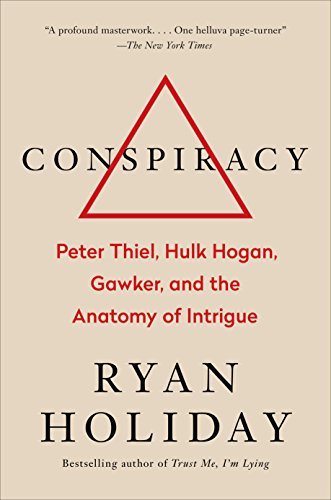 Brooklyn Law School Library’s New Books List for June 1, 2018 is now out with 38 print titles and 41 E-book titles. One book attracted the attention of this writer. Conspiracy: Peter Thiel, Hulk Hogan, Gawker, and the Anatomy of Intrigue tells the story of an astonishing modern media conspiracy. In an age when people compete to be contrarian, it is rare to encounter an astounding proposition. That is what makes Ryan Holiday’s “Conspiracy” such a delight. It takes real nerve, during an investigation into possible collusion to swing the 2016 presidential election, to argue that we might be better off “if more people took up plotting.” Unfortunately for Holiday, and for readers who enjoy a good provocation, his book focuses on a case that demonstrates why transparency beats conspiracy in the long run.
Brooklyn Law School Library’s New Books List for June 1, 2018 is now out with 38 print titles and 41 E-book titles. One book attracted the attention of this writer. Conspiracy: Peter Thiel, Hulk Hogan, Gawker, and the Anatomy of Intrigue tells the story of an astonishing modern media conspiracy. In an age when people compete to be contrarian, it is rare to encounter an astounding proposition. That is what makes Ryan Holiday’s “Conspiracy” such a delight. It takes real nerve, during an investigation into possible collusion to swing the 2016 presidential election, to argue that we might be better off “if more people took up plotting.” Unfortunately for Holiday, and for readers who enjoy a good provocation, his book focuses on a case that demonstrates why transparency beats conspiracy in the long run.
“Conspiracy” chronicles the legal battle between Terry Bollea, or Hulk Hogan, and Gawker Media, the swashbuckling Manhattan publishing group founded by Nick Denton. In 2012, A.J. Daulerio, then editor of the company’s flagship site, published excerpts of a sex tape, recorded in 2006 without Bollea’s consent or knowledge, that showed Bollea in bed with Heather Clem, who was then married to Bollea’s best friend: the radio personality Bubba the Love Sponge. The story was wacky, but it got truly weird. In 2007, Gawker Media acquired a powerful enemy when one of its writers outed PayPal founder and venture capitalist Peter Thiel as gay. Gawker’s Denton, who like Thiel is gay, believed that Thiel’s refusal to be open about being gay was proof that Thiel was “paranoid.” To Thiel, the story was a violation, one that made him into an object of curiosity, in a way he found incomprehensible.
Thiel, as Holiday writes, “venerated privacy, in creating space for weirdos and the politically incorrect to do what they do. Because he believed that’s where progress came from.” What Gawker saw as transparency, Thiel saw as a threat to Silicon Valley. He was so angry at Gawker that he began to refer to it as “the Manhattan Based Terrorist Organization.”
But it took him four years to strike back. In 2011, a Mr. A, whose role is first described in “Conspiracy” but who remains a shadowy figure throughout the book, persuaded Thiel to devote $10 million and five years to a shell company aimed at finding and backing potential lawsuits against Gawker. Among their beneficiaries: Terry Bollea. In 2016, a Florida jury awarded Bollea damages so punishing that Denton had to sell the company. On the surface, it seemed that Thiel’s conspiracy had checkmated Gawker Media.
Holiday, an author and corporate adviser, had unusual access to Thiel and Denton. It is one of the many ironies of this story, and of “Conspiracy,” that talking makes Thiel more sympathetic and comprehensible than plotting ever did. But by the end of the book, it’s clear that, despite Holiday’s argument, Thiel’s conspiracy failed: Thiel killed Gawker, but in doing so undermined his dream of making the Internet a more decent place and securing a more private life for himself. By contrast, Gawker was destroyed not because its leaders failed to conspire, but because they did not pursue the transparency they claimed to believe in.
By the time Thiel did identify himself as Gawker Media’s nemesis after the verdict in Bollea v. Gawker, the narrative of the trial was well on its way to being set. Thiel discovered that it is difficult to come forward and insist that you are the hero of the story when you have already won the sort of surprising and dismaying victory that makes the public inclined to believe that you are the villain. “Cunning and resources might win the war,” Holiday writes toward the end of “Conspiracy,” “but it’s the stories and myths afterwards that will determine who deserved to win it.” The flaw in Thiel’s thinking, and in “Conspiracy,” is in failing to recognize that the stories and the myths that emerge after an event often are the substance of the victory.
